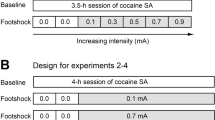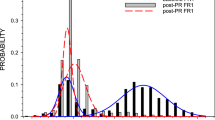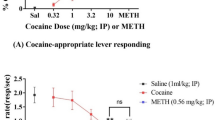Abstract
Recent attempts to model the addiction process in rodents have focused on cocaine self-administration procedures that provide extended daily access. Such procedures produce a characteristic loading phase during which blood levels rapidly rise and then are maintained within an elevated range for the duration of the session. The present experiments tested the hypothesis that multiple fast-rising spikes in cocaine levels contribute to the addiction process more robustly than constant, maintained drug levels. Here, we compared the effects of various cocaine self-administration procedures that produced very different patterns of drug intake and drug dynamics on Pmax, a behavioral economic measure of the motivation to self-administer drug. Two groups received intermittent access (IntA) to cocaine during daily 6-h sessions. Access was limited to twelve 5-min trials that alternated with 25-min timeout periods, using either a hold-down procedure or a fixed ratio 1 (FR1). Cocaine levels could not be maintained with this procedure; instead the animals experienced 12 fast-rising spikes in cocaine levels each day. The IntA groups were compared with groups given 6-h FR1 long access and 2-h short access sessions and two other control groups. Here, we report that cocaine self-administration procedures resulting in repeatedly spiking drug levels produce more robust increases in Pmax than procedures resulting in maintained high levels of cocaine. These results suggest that rapid spiking of brain-cocaine levels is sufficient to increase the motivation to self-administer cocaine.
Similar content being viewed by others
Log in or create a free account to read this content
Gain free access to this article, as well as selected content from this journal and more on nature.com
or
References
Ahmed SH (2005). Imbalance between drug and non-drug reward availability: a major risk factor for addiction. Eur J Pharmacol 526: 9–20.
Ahmed SH, Koob GF (1998). Transition from moderate to excessive drug intake: change in hedonic set point. Science 282: 298–300.
Ahmed SH, Koob GF (1999). Long-lasting increase in the set point for cocaine self-administration after escalation in rats. Psychopharmacology (Berl) 146: 303–312.
Ahmed SH, Koob GF (2005). Transition to drug addiction: a negative reinforcement model based on an allostatic decrease in reward function. Psychopharmacology (Berl) 180: 473–490.
American Psychiatric Association (1994). Diagnostic and Statistical Manual of Mental Disorders, 4th edn. American Psychiatric Press: Washington, DC.
Beveridge TJR, Wray P, Brewer A, Shapiro B, Mahoney JJ, Newton TF et al (2012). Analyzing Human Cocaine Use Patterns to Inform Animal Addiction Model Development. Published abstract for the College on Problems of Drug Dependence Annual Meeting, Palm Springs, CA.
Bickel WK, DeGrandpre RJ, Higgins ST (1993). Behavioral economics: a novel experimental approach to the study of drug dependence. Drug Alcohol Depend 33: 173–192.
Bickel WK, DeGrandpre RJ, Higgins ST, Hughes JR (1990). Behavioral economics of drug self-administration. I. Functional equivalence of response requirement and drug dose. Life Sci 47: 1501–1510.
Brebner K, Phelan R, Roberts DCS (2000). Effect of baclofen on cocaine self-administration in rats reinforced under fixed-ratio 1 and progress-ratio schedules. Psychopharmacol Berl 148: 314–321.
Cosgrove KP, Carroll ME (2002). Effects of bremazocine on self-administration of smoked cocaine base and orally delivered ethanol, phencyclidine, saccharin, and food in rhesus monkeys: a behavioral economic analysis. J Pharmacol Exp Ther 301: 993–1002.
Depoortere RY, Li DH, Lane JD, Emmet-Oglesby MW (1993). Parameters of self-administration of cocaine in rats under a progress-ratio schedule. Pharmacol Biochem Behav 45: 539–548.
Espana RA, Oleson EB, Locke JL, Brookshire BR, Roberts DCS, Jones SR (2010). The hypocretin-orexin system regulates cocaine self-administration via actions on the mesolimbic dopamine system. Eur J Neurosci 31: 336–348.
Ettenberg A, Pettit HO, Bloom FE, Koob GF (1982). Heroin and cocaine intravenous self-administration in rats: mediation by separate neural systems. Psychopharmacology (Berl) 78: 204–209.
Gawin FH (1991). Cocaine addiction: psychology and neurophysiology. Science 251: 1580–1586.
Gorelick DA (2009). The pharmacology of cocaine, amphetamines, and other stimulants. In: Ries RK, Fiellin DA, Miller SC, Saitz R (eds). Principles of Addiction Medicine, 4th edn. Lippincott Williams & Wilkins: Philadelphia, PA, pp 133–157.
Grimm JW, Hope BT, Wise RA, Shaham Y (2001). Neuroadaptation. Incubation of cocaine craving after withdrawal. Nature 412: 141–142.
Hermans A, Keithley RB, Kita JM, Sombers LA, Wightman RM (2008). Dopamine detection with fast-scan cyclic voltammetry used with analog background subtraction. Anal Chem 80: 4040–4048.
Hursh SR (1991). Behavioral economics of drug self-administration and drug abuse policy. J Exp Anal Behav 56: 377–393.
Hursh SR, Winger G (1995). Normalized demand for drugs and other reinforcers. J Exp Anal Behav 64: 373–384.
Javaid JI, Musa MN, Fischman M, Schuster CR, Davis JM (1983). Kinetics of cocaine in humans after intravenous and intranasal administration. Biopharm Drug Dispos 4: 9–18.
Jones SR, Lee TH, Wightman RM, Ellinwood EH (1996). Effects of intermittent and continuous cocaine administration on dopamine release and uptake regulation in the striatum: in vitro voltammetric assessment. Psychopharmacology (Berl) 126: 331–338.
Karan LD, McCance-Katz E, Zajicek A (2009). Pharmacokinetic and pharmacodynamic principles. In: Ries RK, Fiellin DA, Miller SC, Saitz R (eds). Principles of Addiction Medicine, 4th edn. Lippincott Williams & Wilkins: Philadelphia, PA, pp 133–157.
King GR, Joyner C, Ellinwood Jr EH (1994). Continuous or intermittent cocaine administration: effects of flupenthixol treatment during withdrawal. Pharmacol Biochem Behav 49: 883–889.
King GR, Joyner C, Lee T, Kuhn C, Ellinwood Jr EH (1992). Intermittent and continuous cocaine administration: residual behavioral states during withdrawal. Pharmacol Biochem Behav 43: 243–248.
Koob G, Kreek MJ (2007). Stress, dysregulation of drug reward pathways, and the transition to drug dependence. Am J Psychiatry 164: 1149–1159.
Koob GF, Volkow ND (2010). Neurocircuitry of addiction. Neuropsychopharmacology 35: 217–238.
Kumor KM, Sherer MA, Gomez J, Cone E, Jaffe JH (1989). Subjective response during continuous infusion of cocaine. Pharmacol Biochem Behav 33: 443–452.
Liu Y, Morgan D, Roberts DCS (2007). Cross-sensitization of the reinforcing effects of cocaine and amphetamine in rats. Psychopharmacology (Berl) 195: 369–375.
Liu Y, Roberts DCS, Morgan D (2005a). Effects of extended-access self-administration and deprivation on breakpoints maintained by cocaine in rats. Psychopharmacology (Berl) 179: 644–651.
Liu Y, Roberts DCS, Morgan D (2005b). Sensitization of the reinforcing effects of self-administered cocaine in rats: effects of dose and intravenous injection speed. Eur J Neurosci 22: 195–200.
Mantsch JR, Baker DA, Francis DM, Katz ES, Hoks MA, Serge JP (2008). Stressor- and corticotropin releasing factor-induced reinstatement and active stress-related behavioral responses are augmented following long-access cocaine self-administration by rats. Psychopharmacology (Berl) 195: 591–603.
Morgan D, Brebner K, Lynch WJ, Roberts DCS (2002). Increases in the reinforcing efficacy of cocaine after particular histories of reinforcement. Behav Pharmacol 13: 389–396.
Morgan D, Liu Y, Oleson EB, Roberts DCS (2009). Cocaine self-administration on a hold-down schedule of reinforcement in rats. Psychopharmacology (Berl) 201: 601–609.
Morgan D, Roberts DCS (2004). Sensitization to the reinforcing effects of cocaine following binge-abstinent self-administration. Neurosci Biobehav Rev 27: 803–812.
Nicola SM, Deadwyler SA (2000). Firing rate of nucleus accumbens neurons is dopamine-dependent and reflects the timing of cocaine-seeking behavior in rats on a progressive ratio schedule of reinforcement. J Neurosci 20: 5526–5537.
Oleson EB, Richardson JM, Roberts DCS (2011). A novel IV cocaine self-administration procedure in rats: differential effects of dopamine, serotonin, and GABA drug pre-treatments on cocaine consumption and maximal price paid. Psychopharmacology (Berl) 214: 567–577.
Oleson EB, Roberts DCS (2009). Behavioral economic assessment of price and cocaine consumption following self-administration histories that produce escalation of either final ratios or intake. Neuropsychopharmacology 34: 796–804.
Pan HT, Menacherry S, Justice Jr JB (1991). Differences in the pharmacokinetics of cocaine in naive and cocaine-experienced rats. J Neurochem 56: 1299–1306.
Paterson NE, Markou A (2003). Increased motivation for self-administered cocaine after escalated cocaine intake. Neuroreport 14: 2229–2232.
Peoples LL, Cavanaugh D (2003). Differential changes in signal and background firing of accumbal neurons during cocaine self-administration. J Neurophysiol 90: 993–1010.
Peoples LL, Kravitz AV, Lynch KG, Cavanaugh DJ (2007). Accumbal neurons that are activated during cocaine self-administration are spared from inhibitory effects of repeated cocaine self-administration. Neuropsychopharmacology 32: 1141–1158.
Peoples LL, Lynch KG, Lesnock J, Gangadhar N (2004). Accumbal neural responses during the initiation and maintenance of intravenous cocaine self-administration. J Neurophysiol 91: 314–323.
Pickens CL, Airavaara M, Theberge F, Fanous S, Hope BT, Shaham Y (2011). Neurobiology of the incubation of drug craving. Trends Neurosci 34: 411–420.
Quadros IM, Miczek KA (2009). Two modes of intense cocaine bingeing: increased persistence after social defeat stress and increased rate of intake due to extended access conditions in rats. Psychopharmacology (Berl) 206: 109–120.
Reith MEA, Benuck M, Lajtha A (1987). Cocaine disposition in the brain after continuous or intermittent treatment and locomotor stimulation in mice. J Pharmacol Exp Ther 243: 281–287.
Roberts DCS, Andrews MM, Vickers GJ (1996). Baclofen attenuates the reinforcing effects of cocaine in rats. Neuropsychopharmacology 15: 417–423.
Roberts DCS, Loh EA, Vicerks G (1989). Self-adminsitration of cocaine on a progressive ratio schedule in rats: dose-response relationship and effect of haloperidol pretreatment. Psychopharmacol (Berl) 97: 535–538.
Roberts DCS, Morgan D, Liu Y (2007). How to make a rat addicted to cocaine. Prog Neuropsychopharmacol Biol Psychiatry 31: 1614–1624.
Robinson TE, Berridge KC (2008). Review. The incentive sensitization theory of addiction: some current issues. Philos Trans R Soc Lond B Biol Sci 363: 3137–3146.
Samaha AN, Li Y, Robinson TE (2002). The rate of intravenous cocaine administration determines susceptibility to sensitization. J Neurosci 22: 3244–3250.
Seecof R, Tennant Jr FS (1986). Subjective perceptions to the intravenous ″rush″ of heroin and cocaine in opioid addicts. Am J Drug Alcohol Abuse 12: 79–87.
Shou M, Ferrario CR, Schultz KN, Robinson TE, Kennedy RT (2006). Monitoring dopamine in vivo by microdialysis sampling and on-line CE-laser-induced fluorescence. Anal Chem 78: 6717–6725.
Stuber GD, Roitman MF, Phillips PE, Carelli RM, Wightman RM (2005a). Rapid dopamine signaling in the nucleus accumbens during contingent and noncontingent cocaine administration. Neuropsychopharmacology 30: 853–863.
Stuber GD, Wightman RM, Carelli RM (2005b). Extinction of cocaine self-administration reveals functionally and temporally distinct dopaminergic signals in the nucleus accumbens. Neuron 46: 661–669.
Vanderschuren LJ, Everitt BJ (2004). Drug seeking becomes compulsive after prolonged cocaine self-administration. Science 305: 1017–1019.
Vezina P (2004). Sensitization of midbrain dopamine neuron reactivity and the self-administration of psychomotor stimulant drugs. Neurosci Biobehav Rev 27: 827–839.
Volkow ND, Li TK (2009). Drug addiction: the neurobiology of behavior gone awry. In: Ries RK, Fiellin DA, Miller SC, Saitz R (eds). Principles of Addiction Medicine, 4th edn. Lippincott Williams & Wilkins: Philadelphia, PA, pp 133–157.
Wade-Galuska T, Winger G, Woods JH (2007). A behavioral economic analysis of cocaine and remifentanil self-administration in rhesus monkeys. Psychopharmacology (Berl) 194: 563–572.
Wakabayashi KT, Weiss MJ, Pickup KN, Robinson TE (2010). Rats markedly escalate their intake and show a persistent susceptibility to reinstatement only when cocaine is injected rapidly. J Neurosci 30: 11346–11355.
Wee S, Mandyam CD, Lekic DM, Koob GF (2008). Alpha 1-noradrenergic system role in increased motivation for cocaine intake in rats with prolonged access. Eur Neuropsychopharmacol 18: 303–311.
Wilson MC, Hitomi M, Schuster CR (1971). Psychomotor stimulant self administration as a function of dosage per injection in the rhesus monkey. Psychopharmacologia 22: 271–281.
Wise RA, Newton P, Leeb K, Burnette B, Pocock D, Justice Jr JB (1995). Fluctuations in nucleus accumbens dopamine concentration during intravenous cocaine self-administration in rats. Psychopharmacology (Berl) 120: 10–20.
Zernig G, Ahmed SH, Cardinal RN, Morgan D, Acquas E, Foltin RW et al (2007). Explaining the escalation of drug use in substance dependence: models and appropriate animal laboratory tests. Pharmacology 80: 65–119.
Zimmer BA, Dobrin CV, Roberts DCS (2011). Brain-cocaine concentrations determine the dose self-administered by rats on a novel behaviorally dependent dosing schedule. Neuropsychopharmacology 36: 2741–2749.
Zittel-Lazarini A, Cador M, Ahmed SH (2007). A critical transition in cocaine self-administration: behavioral and neurobiological implications. Psychopharmacology (Berl) 192: 337–346.
Acknowledgements
This study was supported by the NIDA research Grants R01 DA14030 (DCSR), P50 DA06634 and R21 DA029405 (Freeman). The excellent technical assistance of Leanne N Thomas and Holly V Buben is gratefully acknowledged.
Author information
Authors and Affiliations
Corresponding author
Ethics declarations
Competing interests
The authors declare no conflict of interest.
Rights and permissions
About this article
Cite this article
Zimmer, B., Oleson, E. & Roberts, D. The Motivation to Self-Administer is Increased After a History of Spiking Brain Levels of Cocaine. Neuropsychopharmacol 37, 1901–1910 (2012). https://doi.org/10.1038/npp.2012.37
Received:
Revised:
Accepted:
Published:
Issue date:
DOI: https://doi.org/10.1038/npp.2012.37
Keywords
This article is cited by
-
Intermittent nicotine access is as effective as continuous access in promoting nicotine seeking and taking in rats
Psychopharmacology (2024)
-
Hierarchical cue control of cocaine seeking in the face of cost
Psychopharmacology (2023)
-
Metabotropic glutamate group II receptor activation in the ventrolateral dorsal striatum suppresses incentive motivation for cocaine in rats
Psychopharmacology (2023)
-
Cocaine-induced plasticity, motivation, and cue responsivity do not differ in obesity-prone vs obesity-resistant rats; implications for food addiction
Psychopharmacology (2023)
-
Impact of high-access exercise prior to and during early adolescence on later vulnerability to opioid use and relapse in male rats
Translational Psychiatry (2022)



